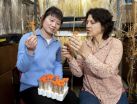(Press-News.org) The animals on the earth have adapted themselves to the environmental temperature changes such as hot in deserts, or cold in the glacial epochs. However, the molecular mechanism for adaptation to thermal environments in the evolutionary process involving temperature sensors was not well understood. Professor Makoto Tominaga and Assistant Professor Shigeru Saito at The National Institute for Physiological Sciences (Okazaki Institute for Integrative Bioscience) demonstrate that the molecule called TRP channels, serve as temperature sensors in animals, sense different temperature ranges between mammals and western clawed frog (amphibians) even the same type of the TRP channels have been investigated. This observation indicates that the temperature sensors can dynamically change their temperature sensitivities to adapt to thermal environments in the evolutionary process. The report is published in American science magazine, PLoS Genetics (electronic edition).
The research was performed in collaboration with Professor Ryuzo Shingai at Iwate University.
In this study, western clawed frog (Xenopus tropicalis) inhabiting the tropics was used. Their optimal ambient temperature is approximately 26 degrees Celsius and temperatures below 20-18 degree Celsius causes detrimental effects. The research team identified the TRPV3 gene, which is know as a warm temperature sensor in mammals, from western clawed frog, and examined its function. They found that the temperature sensitivity of western clawed frog TRPV3 is different from that of mammal TRPV3. TRPV3 channel of mammals was activates by warmth (33-39 degree Celsius or more), but that of western clawed frog was activated by cold temperature (16 degree Celsius or less). Therefore, western clawed frog feels the detrimental low temperature with this temperature sensor. In addition to the difference in temperature sensitivity, the amino-acid sequences of TRPV3 channel in the putative cytosolic termini are highly diversified between western clawed frog and mammals. This structural difference may be involved in the shift in temperature sensitivities of TRPV3 channels. On the other hand, TRPV3 channel of mammal is known to be activated by several chemical compounds, while TRPV3 channel of western clawed frog was not activated by such chemical compounds except for one kind, thus, the chemical sensitivities of TRPV3 channels are also different between western clawed frog and mammals.
"We investigated the evolutionary process of TRPV channel genes, which serve as the temperature sensors in vertebrates, and found that the gene repertoires have been diversified among different vertebrate species. The evolutionary changes of the temperature sensors related to the adaptation to thermal environments or the shift in physiological characteristics were poorly understood. We here clarified one of the molecular mechanism for the functional change "Modal-shift" in temperature sensors. Results of our study indicate that TRPV3 channels have acquired opposite temperature sensitivities during the course of terrestrial vertebrate evolution. This, in turn, indicates that the temperature sensitivity of the thermosensitive TRP channels is not always stable but can change dynamically, even reverses in some cases, during the course of evolution to adapt to thermal environments", said Tominaga
###
This research was supported by Grants-in-Aid for Scientific Research, the MEXT, Japan.
Evolution of the animal temperature sensor: The functional adaptation to environmental change
Functional change ('modal shift') of the TRP channel through evolution
2011-04-08
ELSE PRESS RELEASES FROM THIS DATE:
Fukushima-related measurements by the CTBTO
2011-04-08
Since the double disaster of the 9.0 magnitude earthquake and tsunami that affected hundreds of thousands of people and seriously damaged the Fukushima Daichi power plant in Japan on 11 March 2011, minute traces of radioactive emissions from Fukushima have spread across the entire northern hemisphere. A monitoring network designed to detect signs of nuclear explosions picked up these traces from the stricken power plant.
To date, more than 30 radionuclide stations that are part of the International Monitoring System (IMS) have provided information on the spread of radioactive ...
NASA telescopes join forces to observe unprecedented explosion
2011-04-08
WASHINGTON -- NASA's Swift, Hubble Space Telescope and Chandra X-ray Observatory have teamed up to study one of the most puzzling cosmic blasts yet observed. More than a week later, high-energy radiation continues to brighten and fade from its location.
Astronomers say they have never seen anything this bright, long-lasting and variable before. Usually, gamma-ray bursts mark the destruction of a massive star, but flaring emission from these events never lasts more than a few hours.
Although research is ongoing, astronomers say that the unusual blast likely arose when ...
Lifesaving antibiotics face doubtful future
2011-04-08
[April 7, 2011, WASHINGTON] – To head off a health care disaster, the Infectious Diseases Society of America (IDSA) has developed a plan to combat deadly antibiotic-resistant "super bugs" and is rolling out the multi-pronged plan today, on World Health Day 2011.
Infections are becoming increasingly resistant to existing antibiotics, while the number of new antibiotics being developed has plummeted. IDSA warns that unless sweeping actions are taken now, the future could resemble the days before these miracle drugs were developed. People will die of common infections and ...
Scientists exploit ash tree pest's chemical communication
2011-04-08
This release is available in Spanish.
A newly identified chemical sex attractant, or pheromone, of the emerald ash borer could mean improved traps for monitoring and controlling the tree-killing beetle. That's the goal of U.S. Department of Agriculture (USDA) entomologist Allard Cossé and his colleagues.
Cossé has been searching for such attractants since 2007 as part of a multidisciplinary team of scientists from USDA's Agricultural Research Service (ARS), Forest Service (FS) and Animal and Plant Health Inspection Service (APHIS). Early success came with the identification ...
Starch-controlling gene fuels more protein in soybean plants
2011-04-08
AMES, Iowa – A newly discovered gene introduced into soybean plants has increased the amount of protein in the plant's seed and could hold promise for helping meet nutritional needs of a hungry world.
Eve Wurtele, professor of genetics, development and cell biology; and Ling Li, an adjunct assistant professor and an associate scientist working in her laboratory, have placed a gene found only in Arabidopsis plants into soybean plants and increased the amount of protein in the soybean seeds by 30 to 60 percent.
The results were a pleasant surprise to the researchers as ...
CasinoAUS Network produces EUR22,409.30 Prog Slots Winner
2011-04-08
Australian-themed online casino operators, the CasinoAUS.com Network, have awarded their registered patron KB with the sum of EUR22,409.30 on the player's having won on the Progressive Jackpot slots game LotsaLoot, a highly popular gaming title on the Network. The CasinoAUS.com Network boasts a gaming portfolio of 24 separate titles, 18 of which fall under the online casino slots gaming subcategory. The popularity of Progressive Jackpot games in the online arena - specifically of the online slots variety - is undisputed in the online gaming industry. The reason for this ...
Video games effective treatment for stroke patients: study
2011-04-08
TORONTO, Ont., April 7, 2011 – Virtual reality and other video games can significantly improve motor function in stroke patients, according to research from St. Michael's Hospital.
Patients who played video games, such as Wii and Playstation, were up to five times more likely to show improvements in arm motor function compared to those who had standard therapy.
"Virtual reality gaming is a promising and potentially useful alternative to enhance motor improvement after stroke," said Dr. Gustavo Saposnik, the lead author of the study and the director of the Stroke Outcomes ...
Monitoring system warns of slippery slopes
2011-04-08
Doren in the Austrian Bregenzerwald, February 2007: a slope 650 meters long breaks, resulting in a massive slide into the valley below. The nearest residential buildings are very close to the 70-meter-high rim. This barely avoided catastrophe is not the only incident. Geologists have been monitoring increasingly unstable masses of earth over the past few years in the Alps and other Alpine regions, which have slipped down slopes and on slid unchecked down valleys to more stable substrates. The scientists are primarily looking at heavy rainfall and snowmelt caused by climatie ...
Utah's Immigration Law: A Saner State Solution to a National Issue?
2011-04-08
Border states from California to Texas have been the site of some of the most heated rhetoric over U.S. immigration policy in recent years. After Arizona's passage of its notorious state law dominated American headlines for weeks in 2010, politicians in many states around the country followed suit by introducing similar legislation. Recent legislation approved by the Utah legislature and awaiting its governor's signature is receiving praise as a rare example of "sane" immigration policy.
Key features of the Utah immigration reform bill include enhanced law enforcement, ...
U. Iowa study suggests antidepressants aid physical recovery in stroke
2011-04-08
A University of Iowa study finds that patients treated with a short course of antidepressants after a stroke have significantly greater improvement in physical recovery than patients treated with a placebo. Moreover, the study is the first to demonstrate that this physical recovery continues to improve for at least nine months after the antidepressant medication is stopped.
"The idea that antidepressants might benefit early recovery from stroke has been around for a couple of years," said Robert Robinson, M.D., UI professor and head of psychiatry and senior study author. ...
LAST 30 PRESS RELEASES:
Making lighter work of calculating fluid and heat flow
Normalizing blood sugar can halve heart attack risk
Lowering blood sugar cuts heart attack risk in people with prediabetes
Study links genetic variants to risk of blinding eye disease in premature infants
Non-opioid ‘pain sponge’ therapy halts cartilage degeneration and relieves chronic pain
AI can pick up cultural values by mimicking how kids learn
China’s ecological redlines offer fast track to 30 x 30 global conservation goal
Invisible indoor threats: emerging household contaminants and their growing risks to human health
Adding antibody treatment to chemo boosts outcomes for children with rare cancer
Germline pathogenic variants among women without a history of breast cancer
Tanning beds triple melanoma risk, potentially causing broad DNA damage
Unique bond identified as key to viral infection speed
Indoor tanning makes youthful skin much older on a genetic level
Mouse model sheds new light on the causes and potential solutions to human GI problems linked to muscular dystrophy
The Journal of Nuclear Medicine ahead-of-print tip sheet: December 12, 2025
Smarter tools for peering into the microscopic world
Applications open for funding to conduct research in the Kinsey Institute archives
Global measure underestimates the severity of food insecurity
Child survivors of critical illness are missing out on timely follow up care
Risk-based vs annual breast cancer screening / the WISDOM randomized clinical trial
University of Toronto launches Electric Vehicle Innovation Ontario to accelerate advanced EV technologies and build Canada’s innovation advantage
Early relapse predicts poor outcomes in aggressive blood cancer
American College of Lifestyle Medicine applauds two CMS models aligned with lifestyle medicine practice and reimbursement
Clinical trial finds cannabis use not a barrier to quitting nicotine vaping
Supplemental nutrition assistance program policies and food insecurity
Switching immune cells to “night mode” could limit damage after a heart attack, study suggests
URI-based Global RIghts Project report spotlights continued troubling trends in worldwide inhumane treatment
Neutrophils are less aggressive at night, explaining why nighttime heart attacks cause less damage than daytime events
Menopausal hormone therapy may not pose breast cancer risk for women with BRCA mutations
Mobile health tool may improve quality of life for adolescent and young adult breast cancer survivors
[Press-News.org] Evolution of the animal temperature sensor: The functional adaptation to environmental changeFunctional change ('modal shift') of the TRP channel through evolution


